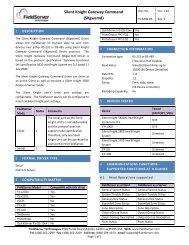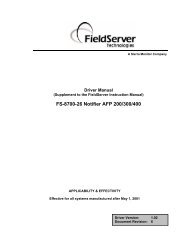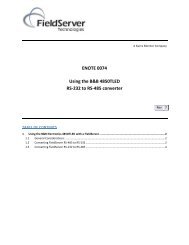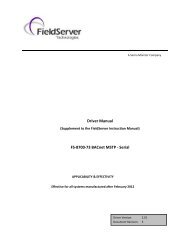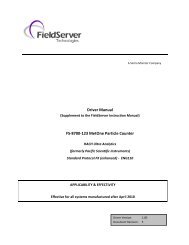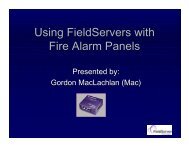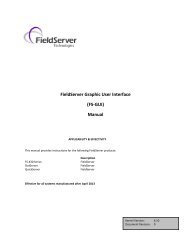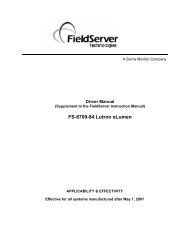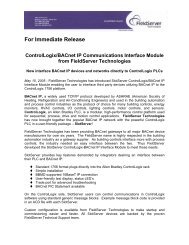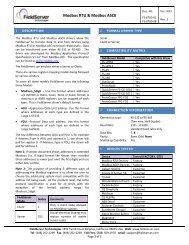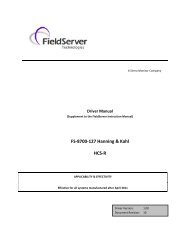Using FieldServers in BACnet Applications
Using FieldServers in BACnet Applications
Using FieldServers in BACnet Applications
You also want an ePaper? Increase the reach of your titles
YUMPU automatically turns print PDFs into web optimized ePapers that Google loves.
<strong>Us<strong>in</strong>g</strong> <strong>FieldServers</strong> <strong>in</strong><br />
<strong>BACnet</strong> <strong>Applications</strong><br />
Presented by:<br />
Gordon MacLachlan (Mac)
Presentation Highlights<br />
The <strong>BACnet</strong> Standard<br />
• <strong>BACnet</strong> organizations<br />
• Protocol hierarchy of functionality<br />
• PICS<br />
• <strong>BACnet</strong> Address<strong>in</strong>g<br />
<strong>BACnet</strong> Variations<br />
<strong>BACnet</strong> <strong>Applications</strong><br />
• Routers vs Gateways<br />
• FieldServer application of <strong>BACnet</strong> properties<br />
• <strong>BACnet</strong> ports<br />
• Priority Arrays<br />
• B<strong>in</strong>ary Text<br />
• BBMD<br />
• Read Property Multiple (RPM)<br />
• <strong>Us<strong>in</strong>g</strong> COV’s with FieldServer<br />
Question and Answer Session
The <strong>BACnet</strong> Standard<br />
Organizations Related to <strong>BACnet</strong><br />
The <strong>BACnet</strong> standard is ma<strong>in</strong>ta<strong>in</strong>ed by ASHRAE (ASHRAE/ANSI<br />
135-2004)<br />
ASHRAE SSPC135 consists of 7 work<strong>in</strong>g groups that focus on<br />
separate aspects of <strong>BACnet</strong> for ma<strong>in</strong>tenance and improvement.<br />
BMA (<strong>BACnet</strong> Manufaturers Association) is a user group that<br />
focuses on the application side of <strong>BACnet</strong> (Interoperability, test<strong>in</strong>g,<br />
t<strong>in</strong>g,<br />
tra<strong>in</strong><strong>in</strong>g, promotion, etc)<br />
BTL (<strong>BACnet</strong> Test<strong>in</strong>g Laboratories) was founded by BMA to<br />
provide an Agency test<strong>in</strong>g standard for vendors to comply to.<br />
BIG-NA (<strong>BACnet</strong> Interest Group of North America) consists of<br />
users, <strong>in</strong>tegrators, contractors etc, and has similar partner<br />
organizations worldwide.
The <strong>BACnet</strong> Standard<br />
<strong>BACnet</strong> Build<strong>in</strong>g Blocks<br />
The <strong>BACnet</strong> protocol conta<strong>in</strong>s the follow<strong>in</strong>g Layers of <strong>in</strong>formation:<br />
• Properties<br />
• Objects<br />
• Devices<br />
• Services<br />
• BIBBs (Bacnet<br />
Interoperability Build<strong>in</strong>g Blocks)<br />
Objects have Properties, , and are conta<strong>in</strong>ed with<strong>in</strong> Devices.<br />
To communicate, these devices need Services that manage the<br />
communication transactions.<br />
Different device types demand different groups of services. BIBBS<br />
def<strong>in</strong>e the classes of services and the level of support these<br />
services need <strong>in</strong> each of the device types.
The <strong>BACnet</strong> Standard<br />
<strong>BACnet</strong> BIBBs - Example<br />
Supported BIBBs<br />
Product<br />
Supported<br />
BIBBs<br />
BIBB Name<br />
Tested<br />
DS-RP-B<br />
Data Shar<strong>in</strong>g-ReadProperty-B<br />
<br />
DS-RPM-B<br />
Data Shar<strong>in</strong>g-ReadPropertyMultiple-B<br />
<br />
Excel Energy<br />
Manager(XEM)<br />
DS-WP-B<br />
DS-WPM-B<br />
Data Shar<strong>in</strong>g-WriteProperty-B<br />
Data Shar<strong>in</strong>g-WritePropertyMultiple-B<br />
<br />
<br />
DM-DDB-B<br />
Device Management-Dynamic-Device-B<strong>in</strong>d<strong>in</strong>g-B<br />
<br />
DM-DOB-B<br />
Device Management-Dynamic-Object-B<strong>in</strong>d<strong>in</strong>g-B
The <strong>BACnet</strong> Standard<br />
What you need to know about PICS:<br />
PICS stands for Protocol Implementation Conformance Statement<br />
Vendors are required to produce a PICS so that users know what<br />
BIBBs, , Services, Objects and Properties they are gett<strong>in</strong>g.<br />
PICS is designed to assist the user <strong>in</strong> determ<strong>in</strong><strong>in</strong>g whether the<br />
Vendor’s s level of <strong>BACnet</strong> support will suffice for the application.<br />
Be sure to read a Vendor’s s PICS before purchas<strong>in</strong>g the product.
<strong>BACnet</strong> Address<strong>in</strong>g:<br />
The <strong>BACnet</strong> Standard<br />
Bacnet po<strong>in</strong>ts (Objects) have addresses that consist of an Object<br />
Type (Data Type) and Object Instance.<br />
There are 25 types of Objects, but different device types only need n<br />
to support a subset of these objects depend<strong>in</strong>g on functionality<br />
required.<br />
Each Object type can have over 4 million <strong>in</strong>stances of objects <strong>in</strong> a<br />
Device.<br />
The comb<strong>in</strong>ation of Object Type and Object Instance def<strong>in</strong>es a<br />
unique object <strong>in</strong> a Device, and is referred to as the Object ID. Two<br />
different devices can possess the same Object ID (eg(<br />
eg: : Two<br />
different devices can both have the po<strong>in</strong>t Analog Input 1, but<br />
because they are on different devices they are unique)<br />
Object ID’s s are usually transparent at host level.
<strong>BACnet</strong> Variations<br />
Variations exist due to a difference <strong>in</strong> connection medium:<br />
<strong>BACnet</strong> PTP – RS-232 Po<strong>in</strong>t to Po<strong>in</strong>t connection<br />
<strong>BACnet</strong> MSTP – RS-485 Token Pass<strong>in</strong>g connection<br />
<strong>BACnet</strong> ARCnet – ARCnet Connection<br />
<strong>BACnet</strong> Ethernet – Ethernet connection, MAC address based<br />
<strong>BACnet</strong> I/P – Ethernet connection, IP address based.<br />
All variations use the same application protocol, but differ at the<br />
transport level due to demands set by the medium.
<strong>BACnet</strong> ARCnet:<br />
<strong>BACnet</strong> Variations<br />
Legacy Protocol. Needs cards for communication. Seldom used.<br />
Cards are becom<strong>in</strong>g hard to f<strong>in</strong>d, and expensive.<br />
Hard to fault f<strong>in</strong>d. No “sniffer” tools available.<br />
Best approach is to replace ARCnet with <strong>BACnet</strong>/IP <strong>in</strong> most<br />
applications.
<strong>BACnet</strong> Variations<br />
<strong>BACnet</strong> PTP:<br />
RS-232 Protocol. Seldom used.<br />
Few vendors support it, but it is a stable protocol.<br />
RS-232<br />
sniffer tools can be used for debugg<strong>in</strong>g problem<br />
applications.
<strong>BACnet</strong> MSTP:<br />
<strong>BACnet</strong> Variations<br />
RS-485 Token Pass<strong>in</strong>g Protocol. Commonly used.<br />
Watch out for dual address<strong>in</strong>g: Some vendors address by MAC<br />
address, others by device ID. FieldServer can support either.<br />
MSTP supports multiple masters on a network by shar<strong>in</strong>g a token<br />
between masters.<br />
TIP: Set Master MAC addresses low so that the Max Master<br />
parameter can be low, allow<strong>in</strong>g m<strong>in</strong>imum overhead.
<strong>BACnet</strong> Ethernet:<br />
<strong>BACnet</strong> Variations<br />
Ethernet Protocol. MAC address based.<br />
All devices communicat<strong>in</strong>g with each other us<strong>in</strong>g <strong>BACnet</strong> Ethernet<br />
MUST be on the same subnet.<br />
Due to the Address base difference, <strong>BACnet</strong> Ethernet and <strong>BACnet</strong><br />
I/P are dist<strong>in</strong>ctly different protocols.<br />
Myth: <strong>BACnet</strong> Ethernet devices do not need an IP address.
<strong>BACnet</strong> Variations<br />
<strong>BACnet</strong> I/P:<br />
Ethernet Protocol. IP address based.<br />
<strong>BACnet</strong> I/P allows for devices on different subnets to communicate<br />
with one another, but BBMD is required.<br />
<strong>BACnet</strong> I/P is also known as Annex J <strong>BACnet</strong>.
Routers vs Gateways:<br />
<strong>BACnet</strong> <strong>Applications</strong><br />
<strong>BACnet</strong> Routers connect <strong>BACnet</strong> networks of dissimilar medium<br />
together (e.g(<br />
e.g: : <strong>BACnet</strong> MSTP to <strong>BACnet</strong> I/P)<br />
Gateways connect networks of dissimilar protocols together (e.g(<br />
e.g:<br />
Modbus RTU to <strong>BACnet</strong> I/P)<br />
The FieldServer is a Gateway.<br />
<strong>BACnet</strong> Routers cannot function as gateways. However, the<br />
FieldServer Gateway can be used <strong>in</strong> applications where a <strong>BACnet</strong><br />
router is required.
<strong>BACnet</strong> <strong>Applications</strong><br />
Standard <strong>BACnet</strong> Properties used <strong>in</strong> the FieldServer:<br />
These map descriptor keywords are used <strong>in</strong>variably <strong>in</strong> FieldServer <strong>BACnet</strong><br />
applications<br />
Map_Descriptor_Name – Used to specify a name for the Object_ID<br />
Data_Type – Used to specify Object_Type<br />
Object_ID – Used to specify the Object_Instance<br />
Units (Server Side) – Used to specify a unit for the Object_ID<br />
Rel<strong>in</strong>quish_Default (Server Side) – Used to specify the rel<strong>in</strong>quished default of a setpo<strong>in</strong>t<br />
Property (Client Side) – Invariably set to Present_Value to request the present value of<br />
the remote Object_ID.<br />
//================================================================================<br />
//<br />
// Server Side Map Descriptors<br />
//<br />
Map_Descriptors<br />
Map_Descriptor_Name Data_Array_Name Data_Array_Offset Function Node_Name Data_Type Object_ID Units Rel<strong>in</strong>quish_Default<br />
Space_Temp_SP DA_AO_01 0 Server FS_11 AO 12 Deg_f 72
<strong>BACnet</strong> <strong>Applications</strong><br />
BBMD (<strong>BACnet</strong> Broadcast Management Device):<br />
<strong>BACnet</strong> as a protocol struggles with operation across network subnets<br />
nets.<br />
This is due to the prolific use of broadcast<strong>in</strong>g <strong>in</strong> the protocol.<br />
<strong>BACnet</strong> solves the problem by assign<strong>in</strong>g a BBMD <strong>in</strong> every subnet. Each E<br />
BBMD listens for broadcasts, and distributes them to other BBMD’s us<strong>in</strong>g<br />
direct messag<strong>in</strong>g. The other BBMD’s then re-broadcast the broadcast<br />
messages.<br />
The FieldServer is capable of be<strong>in</strong>g a BBMD as long as it is not fulfill<strong>in</strong>g a<br />
<strong>BACnet</strong> Client role. A file called bdt.<strong>in</strong>i needs to be loaded <strong>in</strong>to the<br />
FieldServer for this application. Bdt.<strong>in</strong>i stores the IP addresses of all the<br />
BBMD’s on the network, <strong>in</strong>clud<strong>in</strong>g the FieldServer’s s IP address. All<br />
BBMD’s will use the same bdt.<strong>in</strong>i file.<br />
//=============================================<br />
//<br />
// Server Side Connections<br />
//<br />
Connections<br />
Adapter Protocol Connection_Type<br />
N1 Bacnet_IP BBMD
<strong>BACnet</strong> <strong>Applications</strong><br />
<strong>BACnet</strong> Communications Port:<br />
The default communications port for <strong>BACnet</strong> is 47808<br />
The Port number can be changed <strong>in</strong> the Connection parameters by<br />
add<strong>in</strong>g the IP_Port Keyword.<br />
//=============================================<br />
//<br />
// Server Side Connections<br />
//<br />
Connections<br />
Adapter Protocol IP_Port<br />
N1 Bacnet_IP 47809
<strong>BACnet</strong> <strong>Applications</strong><br />
Priority Arrays:<br />
For each Output variable, the FieldServer ma<strong>in</strong>ta<strong>in</strong>s a priority Array A<br />
of<br />
16 priority levels. The value written from each Client is stored <strong>in</strong> this<br />
array at the priority level specified by the Client<br />
The FieldServer also ma<strong>in</strong>ta<strong>in</strong>s a set of flags that <strong>in</strong>dicate which h priority<br />
levels are active<br />
CLIENT 1<br />
Value: 78<br />
Priority: 11<br />
CLIENT 2<br />
Value: 73<br />
Priority: 5<br />
CLIENT 3<br />
Value: 76<br />
Priority: 16<br />
Priority Value Active<br />
1 0 0<br />
2 0 0<br />
3 0 0<br />
4 0 0<br />
5 73 0<br />
6 0 0<br />
7 0 0<br />
8 0 0<br />
9 0 0<br />
10 0 0<br />
11 78 1<br />
12 0 0<br />
13 0 0<br />
14 0 0<br />
15 0 0<br />
16 76 1
Priority Arrays:<br />
<strong>BACnet</strong> <strong>Applications</strong><br />
The FieldServer also copies the value stored <strong>in</strong> the highest active<br />
priority level to the current value for the Output (which is the<br />
Data_Array offset associated with the related server map<br />
descriptor)<br />
If no Priorities are active, then the Rel<strong>in</strong>quish default value is stored<br />
as the current value.<br />
CLIENT 1<br />
Value: 78<br />
Priority: 11<br />
CLIENT 2<br />
Value: 73<br />
Priority: 5<br />
CLIENT 3<br />
Value: 76<br />
Priority: 16<br />
Priority Value Active<br />
1 0 0<br />
2 0 0<br />
3 0 0<br />
4 0 0<br />
5 73 0<br />
6 0 0<br />
7 0 0<br />
8 0 0<br />
9 0 0<br />
10 0 0<br />
11 78 1<br />
12 0 0<br />
13 0 0<br />
14 0 0<br />
15 0 0<br />
16 76 1<br />
Data_Array<br />
Offset: 0<br />
Value: 78
<strong>BACnet</strong> <strong>Applications</strong><br />
Priority Arrays:<br />
The contents of the Priority Array can be assigned to a Data Array for<br />
visualization<br />
//================================================================================<br />
//<br />
// Server Side Map Descriptors<br />
//<br />
Map_Descriptors<br />
Map_Descriptor_NameData_Array_NameData_Array_OffseFunction Node_Name Data_Type Object_ID Rel<strong>in</strong>quish_Default DA_Pri_Array DA_Pri_Array_Offset DA_Pri_In_Use DA_Pri_In_Use_Offset<br />
SMD_AI_01 DA_AI_01 0 Server FS_11 AO 1 20 P_Values 0 P_State 0
<strong>BACnet</strong> <strong>Applications</strong><br />
Active/Inactive Text:<br />
For objects that support these properties, it is possible to specify Active and<br />
Inactive texts for b<strong>in</strong>ary states <strong>in</strong> a Server Side Map Descriptor.<br />
//<br />
// Server Side Map Descriptors<br />
//<br />
Map_Descriptors<br />
Map_Descriptor_NameData_Array_NameData_Array_OffseFunction Node_Name Data_Type Object_ID Active_Text Inactive_Text<br />
Back_Door_Alarm DA_DI_01 0 Server FS_11 DI 1 Alarm Normal
<strong>BACnet</strong> <strong>Applications</strong><br />
Read Property Multiple (RPM):<br />
The FieldServer <strong>in</strong>itiates the RPM function when you specify a Length of<br />
> 1 <strong>in</strong> the map descriptor.<br />
Note that when us<strong>in</strong>g RPM on the server side of the FieldServer, the<br />
FieldServer needs to “Auto-Name” the variables. This is done by<br />
append<strong>in</strong>g the Map_Descriptor_Name with [x], where x is a runn<strong>in</strong>g<br />
number for each variable (start<strong>in</strong>g at 0).<br />
// Server Side Map Descriptors<br />
//<br />
Map_Descriptors<br />
Map_Descriptor_NameData_Array_NameData_Array_OffseFunction Node_Name Data_Type Object_ID Length<br />
DI_Values DA_DI_01 5 Server FS_11 DI 1 4<br />
OBJECT NAME OBJECT_ID Data_Array_Offset<br />
DI_Values[0] DI1 5<br />
DI_Values[1] DI2 6<br />
DI_Values[2] DI3 7<br />
DI_Values[3] DI4 8
<strong>BACnet</strong> <strong>Applications</strong><br />
New to FieldServer: Change of Value (COV):<br />
As a server, FieldServer can accept COV subscriptions for<br />
AI,DI,AO,DO objects.<br />
Both Confirmed and Unconfirmed subscriptions are supported.<br />
Currently available for <strong>BACnet</strong> IP. Will be available on other<br />
<strong>BACnet</strong> drivers soon.<br />
No special configuration required <strong>in</strong> FieldServer server map<br />
descriptor.
Resources<br />
1) www.fieldserver.com<br />
•FieldServer Configuration manual<br />
•FieldServer Troubleshoot<strong>in</strong>g manual<br />
•<strong>BACnet</strong> PICS<br />
•<strong>BACnet</strong> comb<strong>in</strong>ed Data Fact Sheet<br />
•<strong>BACnet</strong> driver manuals<br />
2) www.bacnet.org<br />
•Official ASHRAE SSPC 135 website<br />
3) www.bacnetassociation.org<br />
•BMA website<br />
•Includes BTL and BTL product list<strong>in</strong>gs<br />
4) www.ethereal.com<br />
•Ethernet packet capture utility
Questions<br />
Email Mac at:<br />
sf<strong>in</strong>t@comcast.net
THANK YOU!<br />
…..for tak<strong>in</strong>g the time to attend this<br />
presentation.





